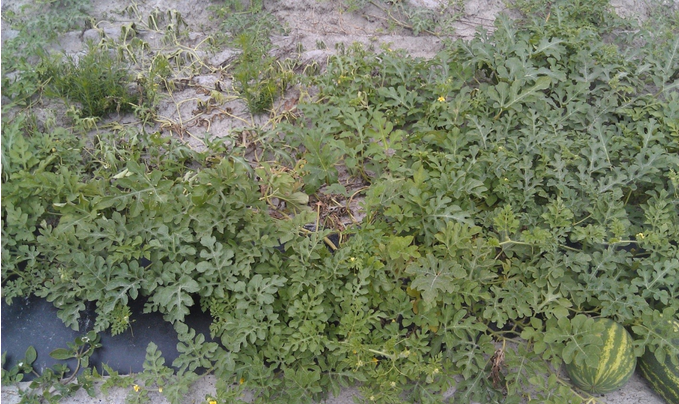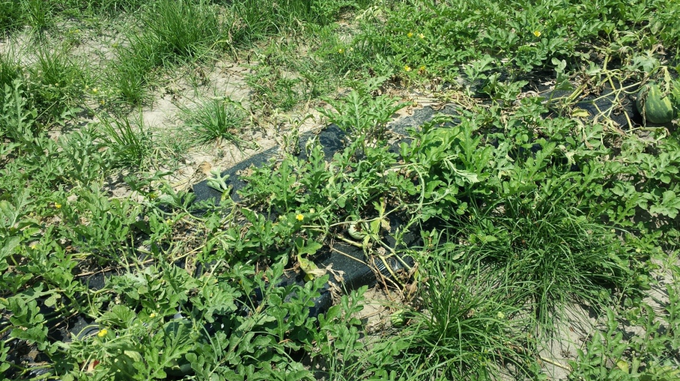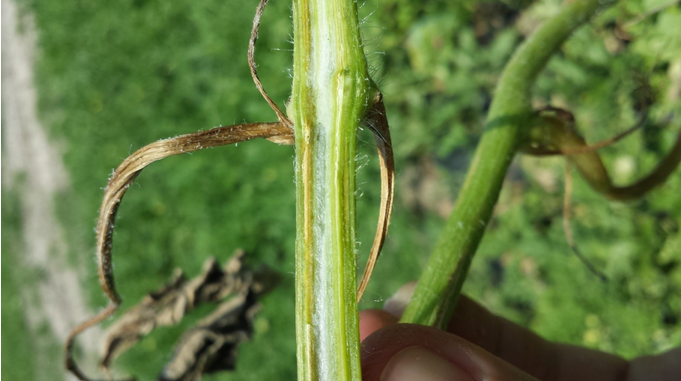
Fig. 1: Early wilting symptoms starting on one side of the plant from the disease Fusarium wilt of watermelon.
Dr. Nicholas Dufault, UF/IFAS Plant Pathologist
Recently, there have been some observational data that suggest North Florida watermelon growers are experiencing an increased incidence of Fusarium wilt in their production fields. While it is uncertain what may have caused this increase, it is apparent that management of this disease has become an important topic for producers throughout region.
Fusarium wilt can be a difficult disease to diagnosis in the field, and often laboratory confirmation of the pathogen in the vascular tissue is needed for identification. A common field symptom of this disease is wilting starting on one side of the plant (Fig. 1 above) which quickly expands throughout the plant. Whole plants can turn brown and die within a matter of a few days (2-3 days) (Fig. 2 below).

Fig. 2: Final symptoms of Fusarium wilt which include complete wilting of the plants leading to brown and dead plant tissue.
Further confirmation of the disease can be made by cutting the vines, stems or tap roots lengthwise to reveal streaks in the vascular tissue that are brown, orange, and/or reddish in color (Fig. 3 below). In Florida, Fusarium wilt is more likely to occur earlier in the season when temperatures are cooler (< 86°F) which is typically prior to fruit set. However, symptoms can occur after fruit set, especially in cooler growing seasons.

Fig. 3: Discoloration of the vascular tissue in a watermelon vine from a severe Fusarium wilt infection.
Fusarium wilt is a widespread disease of watermelon in Florida. One of the best management strategies for this disease is the use of resistant varieties coupled with crop rotations of 4 to 5 years. Unfortunately, resistance to Fusarium wilt is not complete. Fusarium wilt is caused by the pathogen Fusarium oxysporum f. sp. niveum which has 4 races (Race 0, 1, 2, and 3) that vary in their virulence and aggressiveness on watermelon varieties. Many commercial varieties will have some resistance to races 0 and 1, and various newer varieties can have resistance to race 2. Race 3, however, has only been identified in Maryland, but its potential impact on Florida watermelon production is of great concern. The diversity of this pathogen, along with long term survival periods, has limited the effectiveness of using crop rotation and resistant varieties as a management strategy, and leads to the need to use more techniques to properly manage this pest.
Alternative methods to crop rotation and resistant varieties are being explored for the disease management of this important pathogen. Researchers at the University of Florida are currently examining the use of multiple fungicidal products and grafting as a means for integrated disease control. A recent on-farm trial in Alachua County, FL indicated that some fungicidal compounds are useful in reducing the incidence of the disease when compared to untreated plots (Table 1). The impact of this reduction of Fusarium wilt on yield, however, was not assessed and future work is needed to understand these impacts better.
Table 1. The mean number of plants with Fusarium wilt symptoms from the on-farm watermelon research trial in Alachua County. Each product was applied through the drip tape to 3 separate rows that were 375 ft long. Samples of symptomatic plants were collected from the field and confirmed for the presence of Fusarium wilt in the laboratory. |
||
Treatmenta |
Mean Incidenceb |
Percent Reductionc |
Untreated |
33.7 |
0 |
Taegro®ECO |
19.0 |
43.6 |
Proline® |
28.7 |
14.9 |
Quadris® |
26.0 |
22.8 |
|
a All treatments were applied through the drip tape at rates of 5.2 oz, 5.7 fl oz, and 15.4 fl oz per acre for Taegro®ECO, Proline®, and Quadris® respectively. Treatments were applied once 7 days after transplanting. |
||
Unfortunately, there are no silver bullets for Fusarium wilt. Optimal management of this disease will most likely be achieved by an integrated strategy utilizing many of the tools available. Future studies are being planned to examine more thoroughly the effects of fungicidal products and watermelon grafting on the management of this disease as well as seed treatments, SAR (systemic acquired resistance) inducers and cover crops. The goal is to improve the management of Fusarium wilt in Florida, and throughout all the watermelon producing regions of the U.S.
- 2025 End-of-Season Florida Peanut Disease Notes - October 24, 2025
- Southern Rust Confirmed in the Florida Panhandle – June 2025 - June 6, 2025
- Stay Ahead of Disease with the Spore Report: A New Tool to Assist with Potato and Watermelon Management - April 11, 2025
